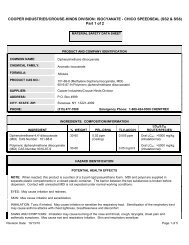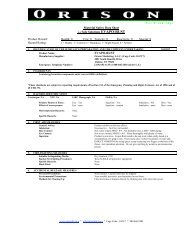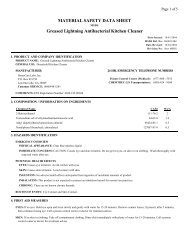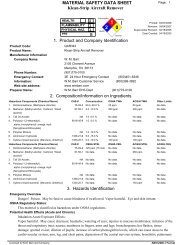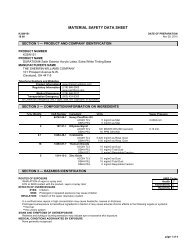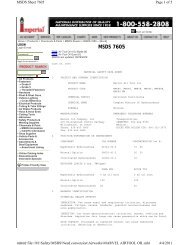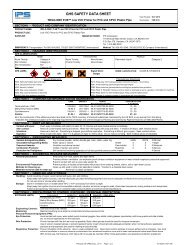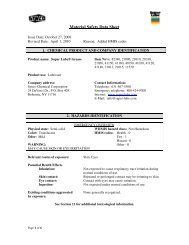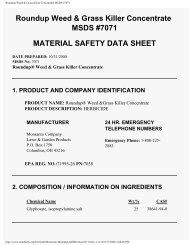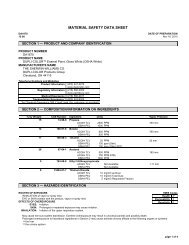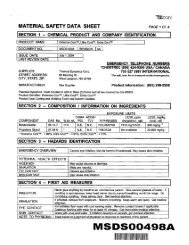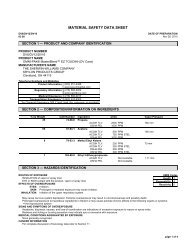MATERIAL SAFETY DATA SHEET - Multi-Craft Contractors, Inc.
MATERIAL SAFETY DATA SHEET - Multi-Craft Contractors, Inc.
MATERIAL SAFETY DATA SHEET - Multi-Craft Contractors, Inc.
You also want an ePaper? Increase the reach of your titles
YUMPU automatically turns print PDFs into web optimized ePapers that Google loves.
9163 Chesapeake Drive, San Diego, CA 92123-1002<br />
619/565-0302<br />
EDITED/UPDATED BY:<br />
John Brown, E-Z Weld, <strong>Inc</strong><br />
DATE OF PRINTING: November 12, 2008<br />
The information contained herein is based on data considered accurate. However, no warranty is expressed or implied regarding the accuracy of these<br />
data or the results to be obtained from the use thereof. Cookson assumes no responsibility for injury to the vendee or third persons proximately caused<br />
by the material if reasonable safety procedures are not adhered to as stipulated in the data sheet. Additionally, Cookson assumes no responsibility for<br />
injury to vendee or third persons proximately caused by abnormal use of the material even if reasonable safety procedures are followed. Furthermore,<br />
vendee assumes the risk in his use of the material.<br />
DEFINITIONS OF TERMS<br />
A large number of abbreviations and acronyms appear on a MSDS. Some of these which are commonly used include the following:<br />
CAS #: This is the Chemical Abstract Service Number which uniquely identifies each constituent. It is used for computer-related searching.<br />
EXPOSURE LIMITS IN AIR:<br />
ACGIH - American Conference of Governmental Industrial Hygienists, a<br />
professional association which establishes exposure limits.<br />
TLV - Threshold Limit Value - an airborne concentration of a substance<br />
which represents conditions under which it is generally believed that nearly<br />
all workers may be repeatedly exposed without adverse effect. The duration<br />
must be considered, including the 8-hour Time Weighted Average (TWA),<br />
the 15-minute Short Term Exposure Limit, and the instantaneous Ceiling<br />
Level (C). Skin absorption effects must also be considered.<br />
OSHA - U.S. Occupational Safety and Health Administration.<br />
PEL - Permissible Exposure Limit - This exposure value means exactly the<br />
same as a TLV, except that it is enforceable by OSHA. The OSHA<br />
Permissible Exposure Limits are based in the 1989 PELs and the June,<br />
1993 Air Contaminants Rule (Federal Register: 58: 35338-35351 and 58:<br />
40191). Both the current PELs and the vacated PELs are indicated. The<br />
phrase, “Vacated 1989 PEL,” is placed next to the PEL which was vacated<br />
by Court Order.<br />
IDLH - Immediately Dangerous to Life and Health - This level represents a<br />
concentration from which one can escape within 30-minutes without<br />
suffering escape-preventing or permanent injury. The DFG - MAK is the<br />
Republic of Germany’s Maximum Exposure Level, similar to the U.S. PEL.<br />
NIOSH is the National Institute of Occupational Safety and Health, which is<br />
the research arm of the U.S. Occupational Safety and Health Administration<br />
(OSHA). NIOSH issues exposure guidelines called Recommended<br />
Exposure Levels (RELs). When no exposure guidelines are established,<br />
an entry of NE is made for reference.<br />
HAZARD RATINGS:<br />
HAZARDOUS <strong>MATERIAL</strong>S IDENTIFICATION SYSTEM: Health Hazard:<br />
0 (minimal acute or chronic exposure hazard); 1 (slight acute or chronic<br />
exposure hazard); 2 (moderate acute or significant chronic exposure<br />
hazard); 3 (severe acute exposure hazard; onetime overexposure can<br />
result in permanent injury and may be fatal); 4 (extreme acute exposure<br />
hazard; onetime overexposure can be fatal). Flammability Hazard: 0<br />
(minimal hazard); 1 (materials that require substantial pre-heating before<br />
burning); 2 (combustible liquid or solids; liquids with a flash point of 38-93°C<br />
[100-200°F]); 3 (Class IB and IC flammable liquids with flash points below<br />
38°C [100°F]); 4 (Class IA flammable liquids with flash points below 23°C<br />
[73°F] and boiling points below 38°C [100°F]. Reactivity Hazard: 0<br />
(normally stable); 1 (material that can become unstable at elevated<br />
temperatures or which can react slightly with water); 2 (materials that are<br />
unstable but do not detonate or which can react violently with water); 3<br />
(materials that can detonate when initiated or which can react explosively<br />
with water); 4 (materials that can detonate at normal temperatures or<br />
pressures).<br />
NATIONAL FIRE PROTECTION ASSOCIATION: Health Hazard: 0<br />
(material that on exposure under fire conditions would offer no hazard<br />
beyond that of ordinary combustible materials); 1 (materials that on<br />
exposure under fire conditions could cause irritation or minor residual<br />
injury); 2 (materials that on intense or continued exposure under fire<br />
conditions could cause temporary incapacitation or possible residual injury);<br />
3 (materials that can on short exposure could cause serious temporary or<br />
residual injury); 4 (materials that under very short exposure could cause<br />
death or major residual injury). Flammability Hazard and Reactivity Hazard:<br />
Refer to definitions for “Hazardous Materials Identification System”.<br />
LVOC PVC CEMENT PRODUCTS<br />
PAGE 12 OF 11<br />
FLAMMABILITY LIMITS IN AIR:<br />
Much of the information related to fire and explosion is derived from the<br />
National Fire Protection Association (NFPA). Flash Point - Minimum<br />
temperature at which a liquid gives off sufficient vapors to form an ignitable<br />
mixture with air. Autoignition Temperature: The minimum temperature<br />
required to initiate combustion in air with no other source of ignition. LEL -<br />
the lowest percent of vapor in air, by volume, that will explode or ignite in<br />
the presence of an ignition source. UEL - the highest percent of vapor in air,<br />
by volume, that will explode or ignite in the presence of an ignition source.<br />
TOXICOLOGICAL INFORMATION:<br />
Human and Animal Toxicology: Possible health hazards as derived from<br />
human data, animal studies, or from the results of studies with similar<br />
compounds are presented. Definitions of some terms used in this section<br />
are: LD 50 - Lethal Dose (solids & liquids) which kills 50% of the exposed<br />
animals; LC 50 - Lethal Concentration (gases) which kills 50% of the<br />
exposed animals; ppm concentration expressed in parts of material per<br />
million parts of air or water; mg/m 3 concentration expressed in weight of<br />
substance per volume of air; mg/kg quantity of material, by weight,<br />
administered to a test subject, based on their body weight in kg. Other<br />
measures of toxicity include TDLo, the lowest dose to cause a symptom<br />
and TCLo the lowest concentration to cause a symptom; TDo, LDLo, and<br />
LDo, or TC, TCo, LCLo, and LCo, the lowest dose (or concentration) to<br />
cause lethal or toxic effects. Cancer Information: The sources are:<br />
IARC - the International Agency for Research on Cancer; NTP - the<br />
National Toxicology Program, RTECS - the Registry of Toxic Effects of<br />
Chemical Substances, OSHA and CAL/OSHA. IARC and NTP rate<br />
chemicals on a scale of decreasing potential to cause human cancer with<br />
rankings from 1 to 4. Subrankings (2A, 2B, etc.) are also used. Other<br />
Information: BEI - ACGIH Biological Exposure Indices, represent the<br />
levels of determinants which are most likely to be observed in specimens<br />
collected from a healthy worker who has been exposed to chemicals to the<br />
same extent as a worker with inhalation exposure to the TLV. Ecological<br />
Information: EC is the effect concentration in water. BCF =<br />
Bioconcentration Factor, which is used to determine if a substance will<br />
concentrate in lifeforms which consume contaminated plant or animal<br />
matter. Coefficient of Oil/Water Distribution is represented by log K ow or<br />
log K oc and is used to assess a substance’s behavior in the environment.<br />
REGULATORY INFORMATION:<br />
U.S. AND CANADA: This section explains the impact of various laws and<br />
regulations on the material. U.S.: EPA is the U.S. Environmental Protection<br />
Agency. DOT is the U.S. Department of Transportation. SARA is the<br />
Superfund Amendments and Reauthorization Act. TSCA is the U.S. Toxic<br />
Substance Control Act. CERCLA (or Superfund) refers to the<br />
Comprehensive Environmental Response, Compensation, and Liability<br />
Act). Labeling is per the American National Standards Institute (ANSI<br />
Z129.1). CANADA: CEPA is the Canadian Environmental Protection<br />
Agency. WHMIS is the Canadian Workplace Hazardous Materials<br />
Information System. TC is Transport Canada. DSL/NDSL are the<br />
Canadian Domestic/Non-Domestic Substances Lists.<br />
EUROPEAN and INTERNATIONAL: EC is the European Community<br />
(formerly known as the EEC, European Economic Community). EINECS:<br />
This the European Inventory of Now-Existing Chemical Substances. IMO is<br />
the International Maritime Organization. The ARD is the European



